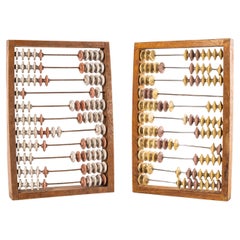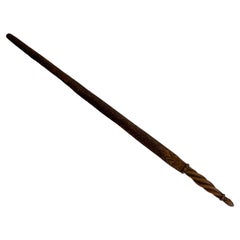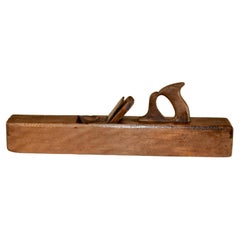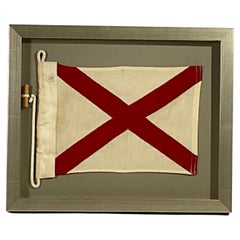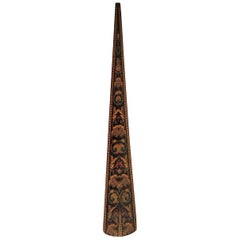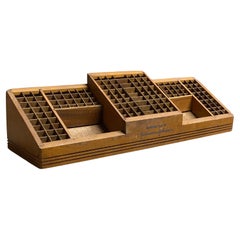Birch Scientific Instruments
to
2
1
3
1
1
1
1
1
1
4,033
898
665
443
246
3
1
1
1
1
3
3
3
Material: Birch
1970's Vintage Framed Abacus - Pair
Located in Hook, Hampshire
1970’s Vintage Framed Abacus – Pair.
Sourced from a collector in the Czech republic this is a pair of large scale abacus used as a class teaching model. In excellent condition.
Wor...
Category
1970s Czech Vintage Birch Scientific Instruments
Materials
Birch
$89 / set
Alnmått (Cubit measure) in Birch with a Noble Crown. Gustavian, dated 1783
Located in Knivsta, SE
Rare Alnmått (Cubit measure) made in Birch with a Noble Crown. From the Gustavian period of the late 1700s, roughly corresponding to the Louis XVI period in France, made in Sweden an...
Category
1780s Swedish Gustavian Antique Birch Scientific Instruments
Materials
Brass
19th Century Trying or Jointer Plane
Located in High Point, NC
19th century trying or jointer plane from England. Lovely patina from age and use.
Category
19th Century English Victorian Antique Birch Scientific Instruments
Materials
Metal
Related Items
Vintage Nautical Signal Flag in Frame
Located in Norwell, MA
Framed maritime signal flag representing the letter “V” in the international code of signals. This authentic and ocean used pennant is made of individual panels of red and white cot...
Category
1980s North American Vintage Birch Scientific Instruments
Materials
Cotton
Rare 19th Century English Tunbridgeware Hair Pin or Slide
Located in Dallas, TX
PRESENTING an EXTREMELY UNIQUE and RARE 19C British Tunbridgeware Hair Pin/Bobbin or Slide.
This slide is unlike any of it’s kind we have seen before, it is a VERY RARE survivor.
From circa 1860 – 80 and made in Tunbridge Wells, England.
Made of walnut with gorgeous marquetry inlay on the entirety of the front with classic Tunbridgeware micro-mosaic all over the front. The rear is walnut.
The marquetry inlay appears to be various different woods, namely, maple, walnut and satinwood.
Would have been worn in a Lady’s hair bun with the micro-mosaic facing forward.
This would have belonged to a VERY ELEGANT LADY in the mid to late 19th Century.
Tunbridge ware is a form of decoratively inlaid woodwork, typically in the form of boxes, that is characteristic of Tonbridge and the spa town of Royal Tunbridge Wells in Kent in the 18th and 19th centuries. The decoration typically consists of a mosaic of many very small pieces of different coloured woods that form a pictorial vignette. Shaped rods and slivers of wood were first carefully glued together, then cut into many thin slices of identical pictorial veneer with a fine saw. Elaborately striped and feathered bandings for framing were pre-formed in a similar fashion.
There is a collection of Tunbridge ware in the Tunbridge Wells Museum and Art Gallery in Tunbridge Wells.
The famous makers of Tunbridge ware were in the Tunbridge Wells area of Kent; their most notable work was from circa 1830-1900.
Early makers of Tunbridge ware, in Tunbridge Wells in the mid-18th century, were the Burrows family, and Fenner and Co. In the 19th century, around 1830, James Burrows invented a technique of creating mosaics from wooden tesserae. Henry Hollamby, apprenticed to the Burrows family, set up on his own in 1842 and became an important manufacturer of Tunbridge ware, employing about 40 people.
Edmund Nye (1797–1863) and his father took over the Fenner company when William Fenner retired in 1840, after 30 years in partnership with him. Thomas Barton (1819–1903), previously apprenticed at the Wise factory, joined the Nyes in 1836, and worked as Nye’s designer; he took over the business in 1863 and continued there until his death.
In Tonbridge (near to Tunbridge Wells), George Wise (1703–1779) is known to have had a business in 1746. It continued with his son Thomas, and Thomas’s nephew George (1779–1869), who took over in 1806. In its early years the company made articles such as workboxes and tea caddies with prints of popular views; later items had pictures created from mosaics. Their workshop in Tonbridge, Wise’s Tunbridge Ware Manufactory, was next to the Big Bridge over the Medway; the building was demolished in 1886 to widen the approach to the bridge.
Tunbridge ware became popular with visitors to the spa town of Tunbridge Wells, who bought them as souvenirs and gifts. Articles included cribbage boards, paperweights, writing slopes, snuffboxes and glove boxes.
At the Great Exhibition of 1851, Tunbridge ware by Edmund Nye, Robert Russell and Henry Hollamby was shown; Edmund Nye received a commendation from the judges for his work. He exhibited a table depicting a mosaic of a ship at sea; 110,800 tesserae were used in making the picture.
The manufacturers of Tunbridge ware were cottage industries, and they were no more than nine in Tunbridge Wells and one in Tonbridge. The number declined in the 1880s; competent craftsmen were hard to find, and public tastes changed. After the death of Thomas Barton in 1903 the only surviving firm was Boyce, Brown and Kemp, which closed in 1927.
Marquetry was an old technique which was continued by Nye and Barton to create images such as birds or butterflies.
‘Green Oak’ as caused by the fungus Chlorociboria aeruginascens.
Stickware and half-square mosaic was invented by James Burrows in about 1830: a bunch of wooden sticks of different colours, each having triangular or diamond-shaped cross section, were tightly glued together; in the case of stickware, the resulting block was dried, then turned to form an article such as the base of a pincushion. For half-square mosaic, thin slices were taken from the composite block, and applied to a surface.
Tesselated mosaic, was a development by James Burrows of half-square mosaic; it was adopted by George Wise and Edmund Nye. Minute tesserae were used to form a wide variety of geometric and pictorial designs.
Many sorts of wood were used for the various colours; about 40 were in regular use. Only natural colors were used; green was provided by “green oak”, produced by the action of fungus on fallen oak. Designs for articles were often taken from designs of Berlin wool work.
Category
Late 19th Century English High Victorian Antique Birch Scientific Instruments
Materials
Satinwood, Walnut
Vintage Nautical Signal Flag in Frame
Located in Norwell, MA
Framed maritime signal flag representing the letter “B” in the international code of signals. This authentic and ocean used pennant is made of an individual panel of red. Fitted to a...
Category
1980s North American Vintage Birch Scientific Instruments
Materials
Cotton
19th Century Pet or Doll Bed
Located in East Hampton, NY
Exquisite pet/ doll bed in the Louis XXI style. all original silk brocade drapery and upholstery. and remnants of trims. mattress is stuffed horsehair. ostrich feather floret. (the h...
Category
Mid-19th Century Antique Birch Scientific Instruments
Materials
Silk
Staunton Fierce Knight Weighted Club Chess Set 8.5cm Kings Jointed Box, 19th C
Located in Lincoln, Lincolnshire
This is a very good quality and complete English handmade hardwood "Weighted" Club Chess Set game of 32 pieces, in the Staunton Fierce Knight pattern, all within a jointed wood box ...
Category
Late 19th Century British Late Victorian Antique Birch Scientific Instruments
Materials
Hardwood
$1,061
H 3.5 in W 6.5 in D 4.5 in
Vintage Nautical Signal Flag in Frame
Located in Norwell, MA
Framed maritime signal flag representing the letter “U” in the international code of signals. This authentic and ocean used pennant is made of individual panels of red and white cot...
Category
1950s North American Vintage Birch Scientific Instruments
Materials
Cotton
Antique Real Chinese Abacus
Located in Somis, CA
This is an authentic, original Chinese abacus that was actually used in the early 20th century. The abacus, an ingenious calculator, has been a vital tool in China for over a thousan...
Category
Early 20th Century Chinese Birch Scientific Instruments
Materials
Metal
19th C Games Compendium in Hardwood Jointed Box over eight Games, Victorian
Located in Lincoln, Lincolnshire
This is a high quality antique Games Compendium, complete with over 8 individual games in its original hardwood storage box with a hinged lid, all dating to the Victorian period of the 19th Century.
All the pieces are well made and complete.
The box is made of a jointed hardwood, possibly red walnut and is a high quality piece in its own right.
The box has developed a lovely color and patination from use and wear.
The box lid has two brass hinges and two brass loop catches to secure it closed. The interior is sectioned into different sub compartments by hardwood dividers.
Many different games are included within the compendium, including;
Horse racing game...
Category
19th Century English Victorian Antique Birch Scientific Instruments
Materials
Brass
$1,472
H 3.15 in W 12.38 in D 7.8 in
19th Century Wood Boots Trees Molds or Forms
Located in Carimate, Como
19th century wooden riding boot trees, molds or forms. Great decorative and conversational piece, ideal for decorative purpose.
Category
Late 19th Century Italian Antique Birch Scientific Instruments
Materials
Wood
Vintage B&L Ray-Ban 1970's Eve-Opty1 Oversized Round Tortoise Frame Sunglasses
Located in St. Louis, MO
This is a nice vintage pair of Bausch & Lomb ( B&L - Ray-Ban ) oversized sunglasses having translucent tortoise frame with grey plastic lenses.
Marked on frames : B&L - Ray-Ban, m...
Category
1970s Canadian Hollywood Regency Vintage Birch Scientific Instruments
Materials
Plastic
$155
H 2.63 in W 6 in D 5.75 in
19th Century French Automaton
Located in San Francisco, CA
Fabulous rare 19th century automaton. Most likely made in France at the end of the 19th century. She is a real beauty and in remarkable condition for her age. She is made of porcelain and cloth. When you wind her she bends her head and raises bouquet to smell the flowers. With the stand she is 15 1/2 inches high. Just herself measures 11 1/2 inches high. Approximately 5 1/2 inches in width and depth. There is a monogram on the back of her neck that appears to be the letter C...
Category
19th Century French Victorian Antique Birch Scientific Instruments
Materials
Porcelain
Fine 19th C. German Wood Brass Carpenters Plough Plane Signed Steinlin
Located in Rochester, NY
Antique 19th century German screw arm plough plane carpenters tool in beautifully aged original old color patina to wood and brass w/ very fine hand crafted construction. Stamped Ste...
Category
19th Century German Antique Birch Scientific Instruments
Materials
Brass, Steel
Previously Available Items
1930s Johnson & Johnson Art Deco Counter Top Display
Located in Garnerville, NY
Johnson & Johnson center top or wall hanging apothecary display. Originally found in at pharmacies, druggists or general stores. Each opening was fi...
Category
1930s American Art Deco Vintage Birch Scientific Instruments
Materials
Wood, Birch, Maple, Masonite, Plywood
Recently Viewed
View AllMore Ways To Browse
Large Abacus
Large Brass Telescope
Marine Barometer
Plate Camera
Pocket Compass
Used Stanley Tools
Vintage Beakers
W And T Avery Scales Antique
Wooden Instrument Case
16th Century Bronze Mortar
19Th Century Antique Cameras
3 Draw Brass Telescope
Anatomical Wax
Antique Brass Ruler
Antique Brass Scoop
Antique Brass Sundials
Antique Magnetic Compass
Antique Monocular
